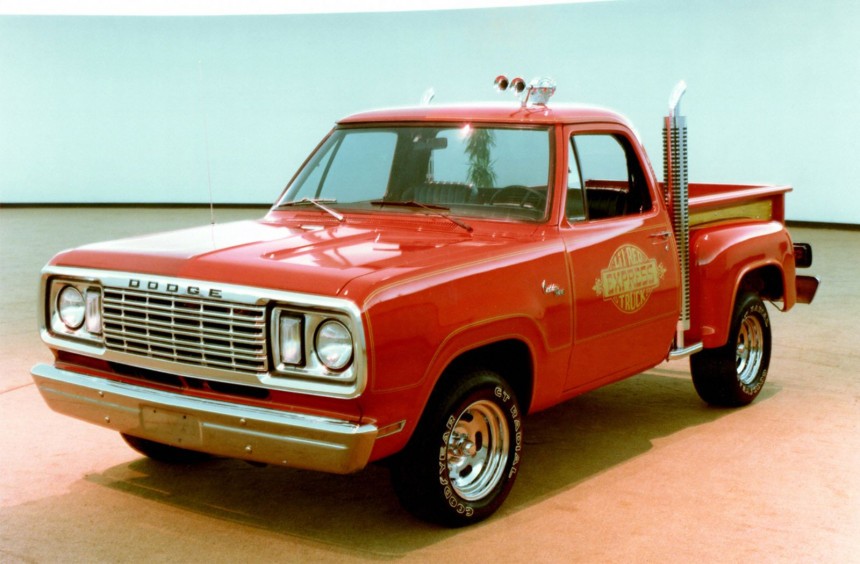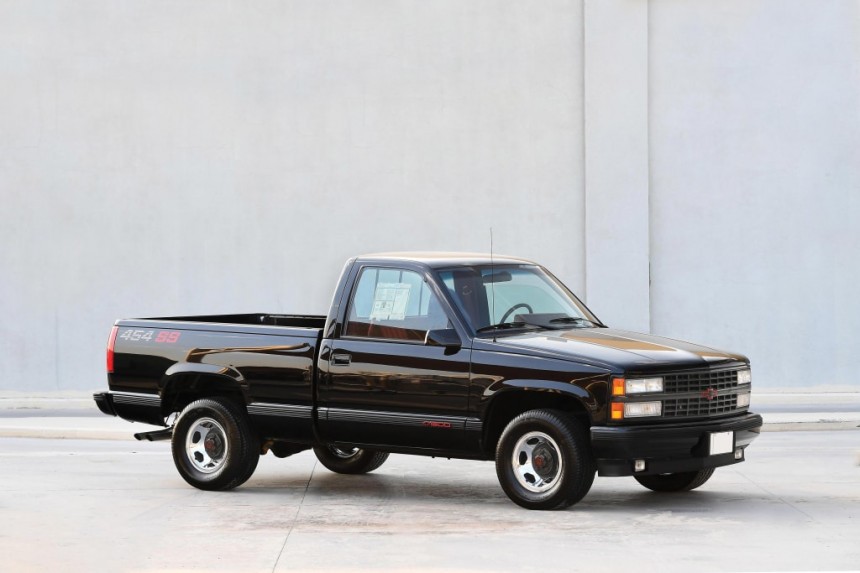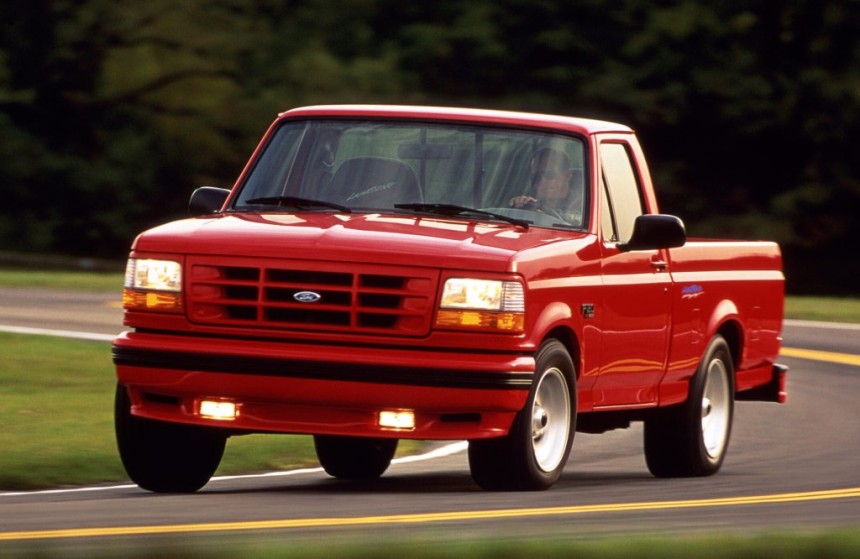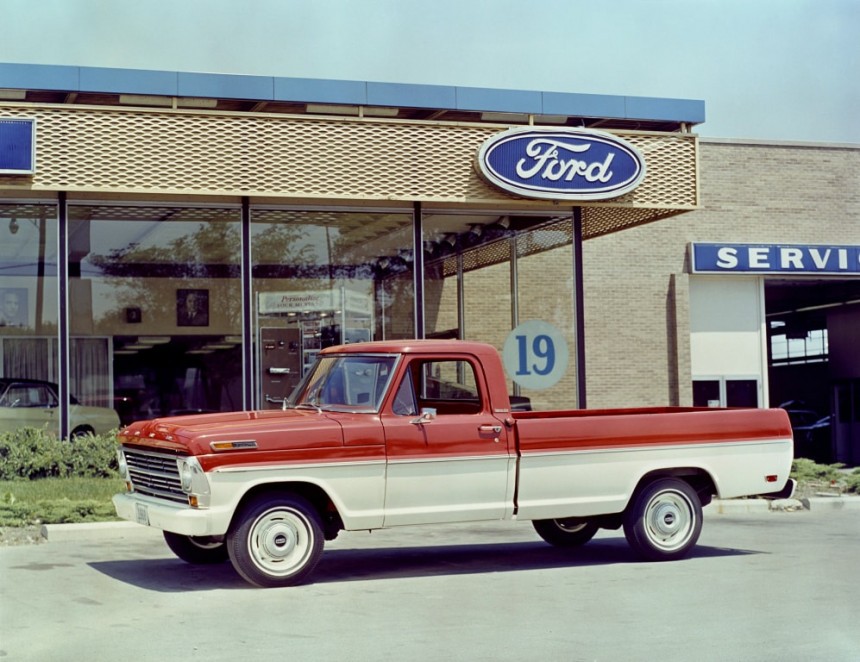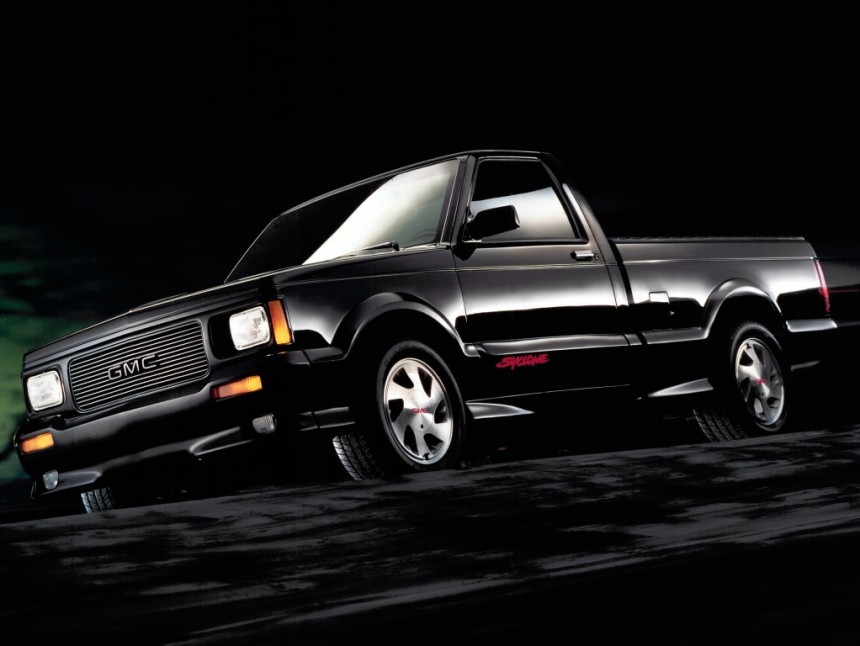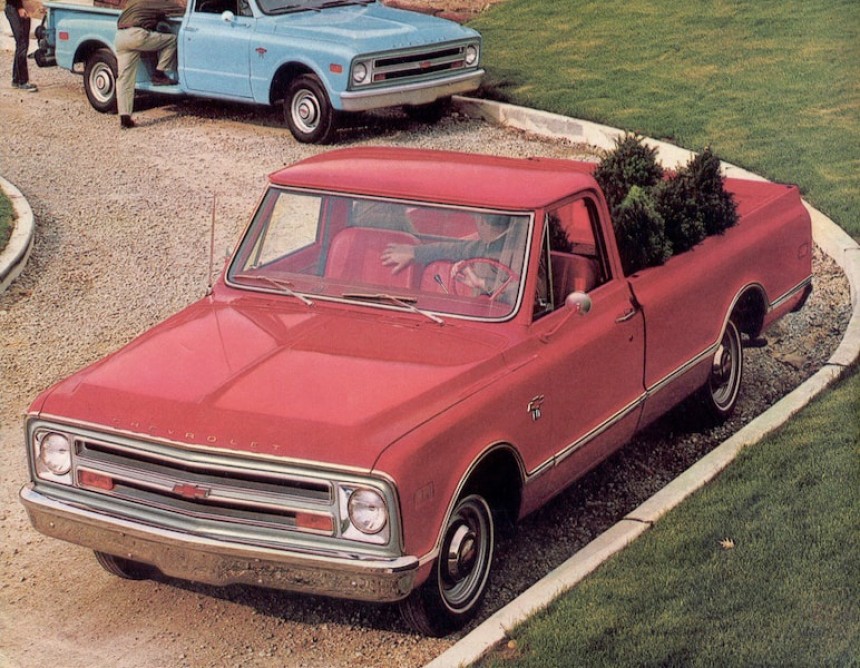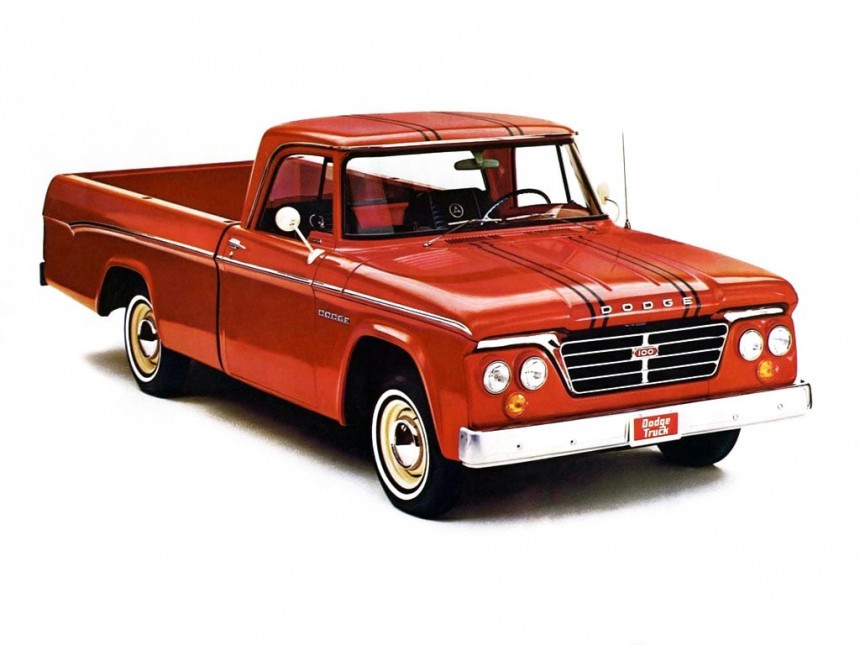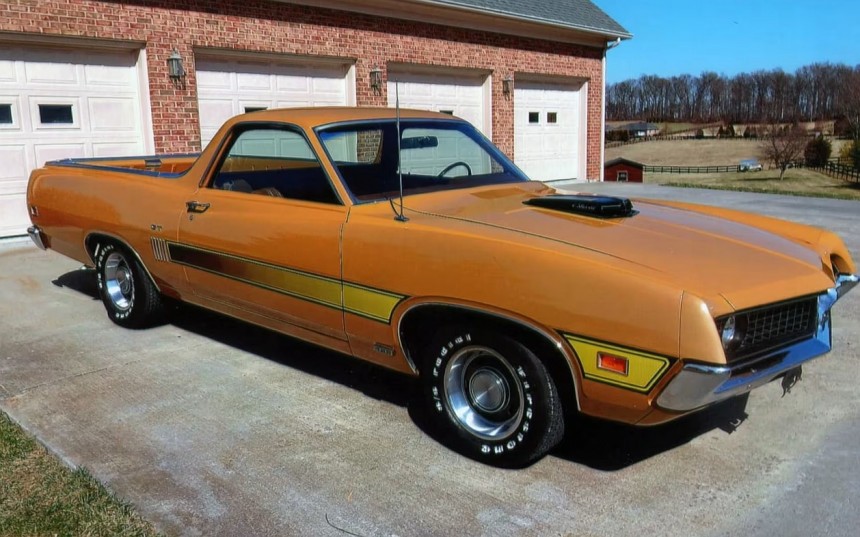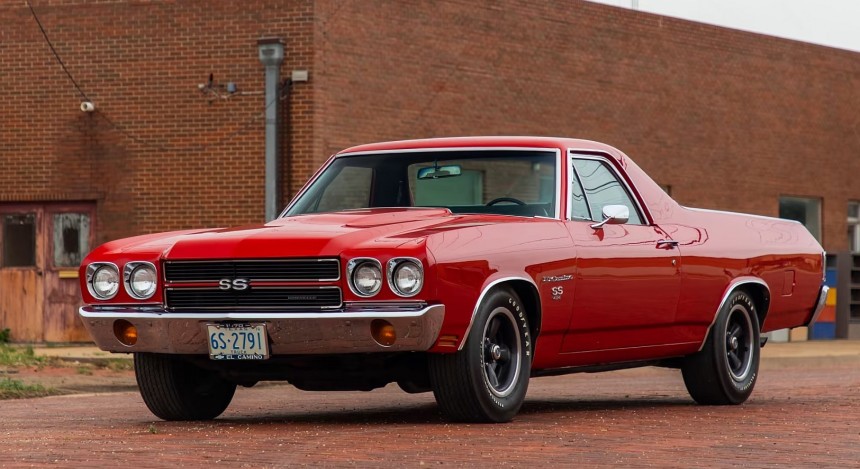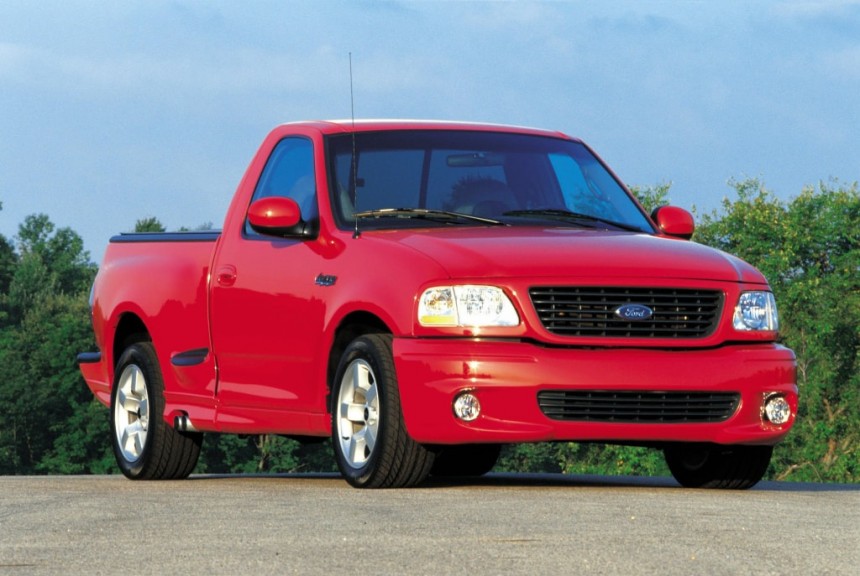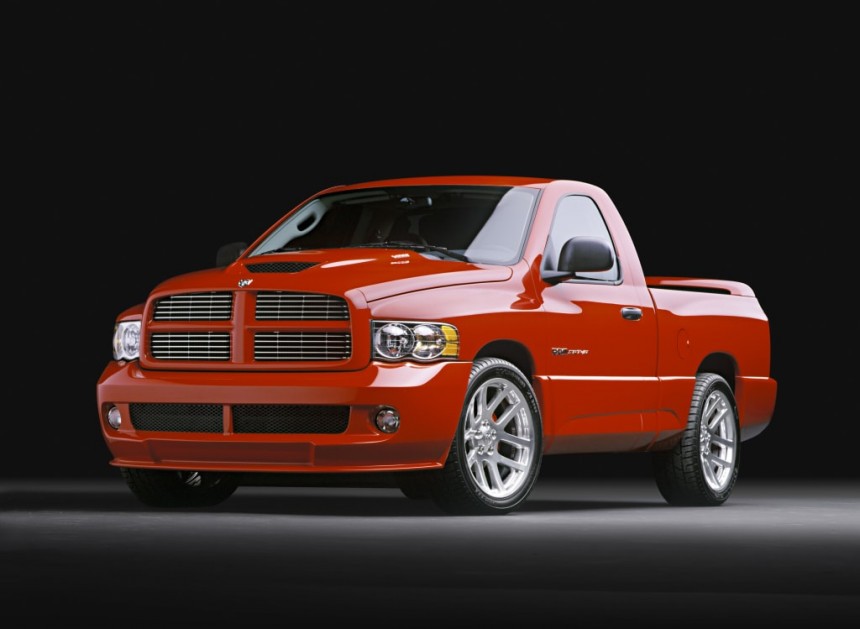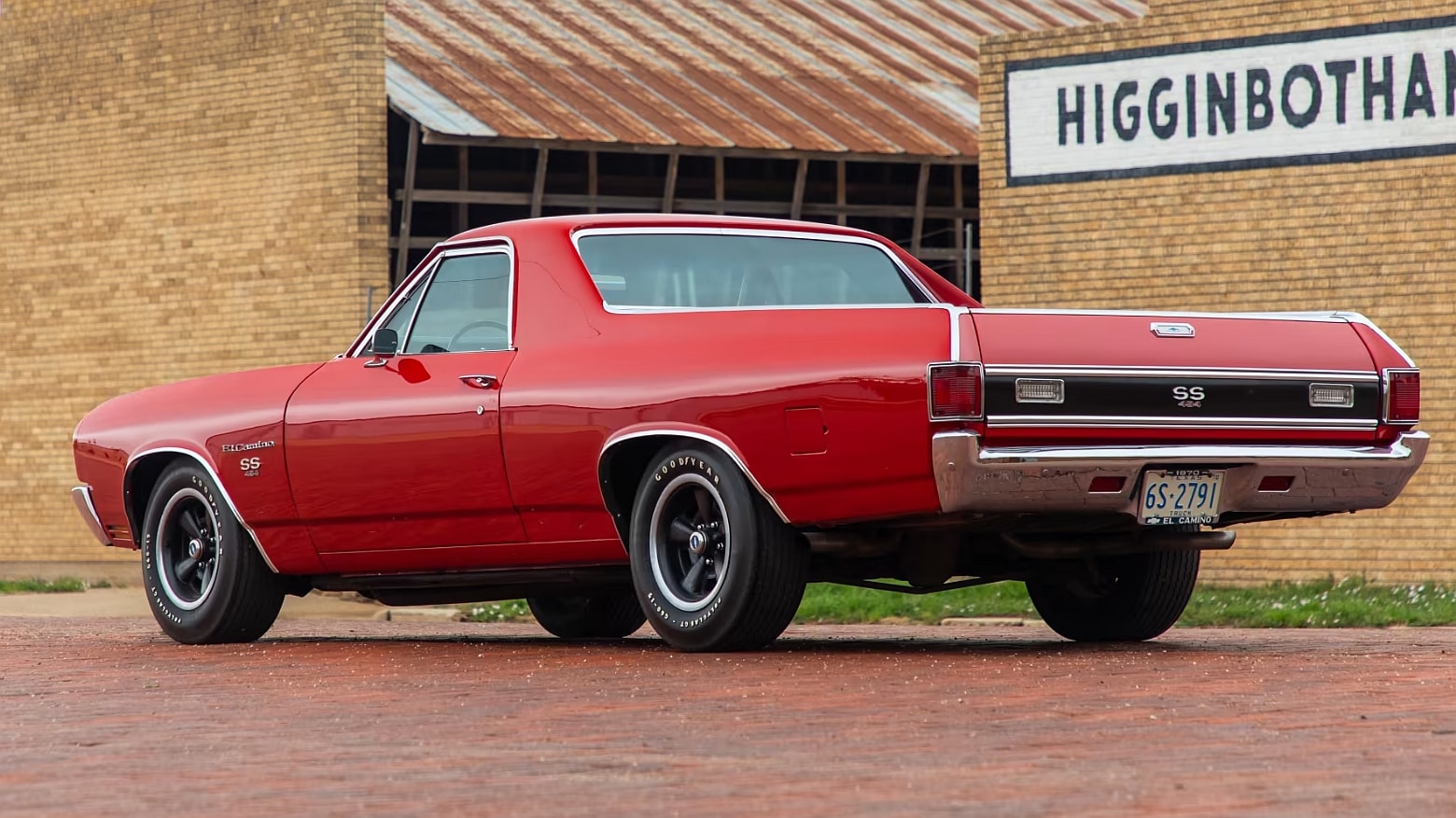
Pickup trucks have been around since the early days of the automobile. Specifically, Rapid Motor Vehicle Company built one-ton pickups as early as 1902, some 15 years before Ford introduced the Model TT. Initially conceived as no-frills, rugged workhorses, pickup trucks evolved to include more convenience features. And as automobiles became increasingly more powerful starting in the 1950s, trucks also became available with performance-oriented drivetrains.
10. 1978 Dodge Li’l Red Express – 225 HP
The first truck on my list comes from the Malaera Era. It was a time when American automakers struggled to adjust to the oil crisis and the more stringent fuel economy and emissions regulations.
It was 1978, and muscle cars were a thing of the past. The second-generation Mustang was on its way out with a V8 engine that generated only 141 horsepower. The Chevrolet Camaro was doing a bit better with 185 horsepower on tap, but the 200-horsepower mark was unattainable for vehicles once considered muscle cars.
Except for the Pontiac Firebird Trans-Am, which was available with a 220-horsepower of the company’s 400-cubic-inch (6.6-liter) V8. The Corvette also delivered a similar amount from a 350-cubic-inch (5.7-liter) small-block, but that was about it. By comparison, the Dodge Li’l Red Express was one mighty truck.
But how was that possible with so many restrictions in place? Well, trucks were exempt from the emission regulations that plagued automobiles at the time. Dodge used this to its advantage and created a powerful hauler.
Fitted with a 360-cubic-inch (5.9-liter) Interceptor-spec V8. the Li’l Red Express had 225 horsepower and 295 pound-feet (400 Nm) to throw around. For reference, the contemporary Ford F-Series and Chevrolet C/K did not exceed 170 horsepower.
The oomph enabled the hauler to hit 60 mph (97 kph) from a standing start in just 6.7 seconds, a figure superior to American sports cars. Moreover, in a test run by Car and Driver, the Li’l Red Express came out as the fastest American-built production vehicle in terms of 0-to-100 mph (161 kph) acceleration. It hit the benchmark in 19.9 seconds, quicker than the Corvette.
Styling-wise, the truck was no sleeper. Finished in bright red paint complemented by gold decals on the doors and tailgate, the Li’l Red Express sported semi-style exhaust stacks as tall as the roof. It was a fully-fledged factory hot rod.
The truck wasn’t around for long, though. Dodge discontinued the Li’l Red Express after only two model years and 7,306 units sold.
9. 1990 Chevrolet 454 SS – 230-255 HP
Based on the fourth-generation Chevrolet C/K, the 454 SS arrived in 1990 as the first performance-oriented truck since the Li’l Red Express. That’s right, Detroit needed 12 years to revisit the concept.
Sporting the “454” and “SS” badges made famous by the Chevelle during the golden muscle car era, the truck was some sort of spiritual successor to the Shelby Dakota. The latter had been produced in 1989 in cooperation with Shelby American, but it wasn’t notably more potent than a regular rig at 175 horsepower.
The 454 SS, on the other hand, got a 454-cubic-inch (7.4-liter) V8 usually found in the larger 3500-series trucks. Initially mated to a three-speed automatic, the lump delivered 230 horsepower. The output increased to 255 horses in 1991, a year that also saw the introduction of a four-speed manual.
The 454 SS didn’t look as flamboyant as the Shelby Dakota, though. Chevrolet opted for a monochrome layout with everything finished in black on the outside. It was the only color option for 1990 and 1991, paired with a red interior.
In 1992, the 454 SS also became available in red and white, while interior options expanded to include blue, beige, and gray. The package also included an upgraded suspension on gas shock absorbers and a front stabilizer bar.
A moderate success in its first year on the market, the 454 SS sold poorly through 1993, its final year in showrooms. Chevrolet delivered 16,953 examples, 13,748 of which were sold in 1990.
8. 1993 Ford SVT Lightning – 240 HP
The “Lightning” badge may be found on an all-electric F-150 nowadays, but its career began on a performance truck. The SVT Lightning was created to compete with the 454 SS and arrived in 1992, just a few months before the Chevy went into the history books.
The recipe was very similar. Ford took a single-cab F-150, gave it a monochrome look, and stuffed it with a beefed-up V8 engine. The mill in question was a 5.8-liter Windsor rated at 240 horsepower and 340 pound-feet (461 Nm) of twist. An automatic was the only available transmission.
Other goodies included an aluminum driveshaft, a limited-slip differential, custom-calibrated shocks, front and rear anti-roll bars, and thicker frame rails from the heavy-duty F-250 trucks. The SVT Lightning was fine-tuned by iconic racing driver Jackie Stewart.
Although the 454 SS was gone by 1993, the Lightning remained in showrooms through the 1995 model year. The truck was a slow seller and moved only 11,563 units by the time it was discontinued.
Ford revived the nameplate for the 1999 model year. The second-generation performance truck, which we will discuss below, remained in production until 2004.
It’s also worth noting that the SVT Lightning was the most potent Ford hauler at the time. In 1994, the company introduced a 7.5-liter V8 good for 245 horses. The unit was only available in heavy-duty trucks.
7. 1968 Ford F-100 – 255 HP
For our next truck, we travel back in time to the golden muscle car era. Yup, cars weren’t the only vehicles that arrived with solid oomph in dealerships at the time. Granted, pickup trucks were still seen as workhorses, but automakers were already experimenting with car-like features, and big power haulers were becoming a thing.
Ford launched a brand-new F-Series truck in 1967 with an optional 352-cubic-inch (5.8-liter) V8 good for 208 horsepower. The following year, the truck got the now-iconic 390-cubic-inch (6.4-liter) FE. Although not quite as powerful as the Ford Mustang or the Mercury Cougar, the FE put the F-100 into 250-horsepower territory.
But unlike the pickups we already discussed, the engine did not come with a specific package. Strangely enough, for an era when Ford offered all sorts of bundles across the car board, the range-topping F-Series got no extras. Well, I guess we could call it a moderate sleeper.
6. 1969 Chevrolet C20 Longhorn – 255 HP
Chevrolet also offered potent trucks in the golden muscle car era. The 1967 model year saw the arrival of the mighty Camaro. However, the company also unleashed the second-generation C/K truck, also known as the Action Line. The hauler soldiered on through 1972, getting significant changes as the Malaise Era loomed.
Of course, the C/K workhorse could also be had with a base inline-six and a myriad of V8 engines rated at under 200 horsepower. However, Chevy introduced a more powerful 350-cubic-inch V8 in 1969.
Shared with nearly every Chevy automobile produced at the time, the small-block delivered 255 horsepower and a healthy 350 pound-feet (475 Nm) of torque. Available as RPO code LS9, the mill was available with any trim level and found its way into the 3/4-ton C20 lineup.
When paired with the Longhorn option, which included a longer wheelbase and an 8.5-foot bed, the 255-horsepower V8 turned the C20 into a capable, all-around hauler. The high output also made it a popular camper conversion.
5. 1991 GMC Syclone – 280 HP
And we’re back into the early 1990s for this one. They say it’s the stablemate of the Chevrolet 454 SS, but it’s more than a rebadged rig. That’s mainly because this high-performance version of the GMC Sonoma truck doesn’t have a V8 under the hood.
Produced by GMC along with Production Automotive Services (PAS), the Syclone hit dealerships in 1991 with a 4.3-liter V6 under the hood. Featuring a Mitsubishi turbocharger and a Garrett intercooler, the unit produced 280 horsepower and 350 pound-feet (475 of torque). That’s a significant 25-horsepower increase over the Chevy 454 SS.
The truck was impressively quick for the era, as it needed only 4.3 seconds to hit 60 mph from a standing start. The quarter-mile came in at only 13.4 seconds, as quick as most range-topping muscle cars from the era.
Moreover, the Syclone was, at its introduction, the fastest stock pickup truck in the world and one of the quickest vehicles. In a famous test performed by Car and Driver, the Syclone outgunned a Ferrari 348 TS.
Like most high-performance trucks, the Syclone was short-lived. GMC discontinued the beefed-up hauler after only one model year and 2,998 units produced. The final three examples were built during the 1992 model year.
4. 1968 Chevrolet C10 – 325 HP
Remember the 255-horsepower 350 V8 I mentioned earlier? Well, it wasn’t the most potent unit Chevy offered in the second-generation C/K. The truck was also available with a 396-cubic-inch (6.5-liter) big-block V8 that sent 325 horsepower and 410 pound-feet (556 Nm) of twist to the wheels.
Yup, I’m talking about the same powerplant that propelled many nameplates into muscle car territory. This bad boy moved not only the Camaro, Chevelle, and the Nova but also the Monte Carlo and the El Camino. And, of course, it also found its way into the company’s full-size rigs, including the Impala and the Caprice.
Although the C10 wasn’t available with the 350 and 375 horsepower versions available in Chevy cars in 1968, we could still say that it turned the C/K into a proper muscle truck. But was it the most potent pickup of the era? Nope! And here’s why.
3. 1964 Dodge D-100 Street Wedge – 365 HP
Although Chevrolet is often credited for having produced the first truck with over 300 horsepower, Dodge did it a few years before its Detroit rival. It happened in 1963 when Chrysler had the wonderful idea to drop its Street Wedge V8 in a D-Series truck.
It was part of the High-Performance package, an option available on both the base truck and the Custom Sports Special at the time. The early trucks left the assembly line with the 413-cubic-inch (6.8-liter) engine, but Dodge soon began fitting the enlarged 426-cubic-inch (7.0-liter) unit.
Not to be confused with the HEMI, the Street Wedge was a streetable version of the race-ready Max Wedge powerplant. And while it wasn’t as powerful as the latter (rated at up to 425 horsepower), the Street Wedge provided a whopping 365 horses. That was enough to send the truck down the quarter mile in less than 16 seconds and turn it into the fastest production truck of its time.
Production-wise, the D-100 Street Wedge is a bit of a mystery. While the truck was advertised for three years, the number of units that left the assembly line is disputed. Some claim Dodge built as many as 50 trucks, while others say the number is unknown. The CSS/High Performance Package Registry, on the other hand, lists 27 examples.
Regardless, the D-100 Street Wedge is an awesome truck, a fully-fledged sleeper, and the true grandfather of high-performance pickups.
2. 1970 Ford Ranchero Cobra Jet – 370 HP
I know the Ranchero is actually a car with a bed, but I can’t complete this list without it. And besides, the coupe utility segment was a thing back in the day. The Ranchero was launched in 1957 and it was available with potent V8 power since day one.
However, things got more serious in the late 1960s. With the muscle car wars in full swing, Ford decided to use the 428-cubic-inch (7.0-liter) Cobra Jet in its midsize car-based truck. A mid-1968 option, the mill turned the Ranchero into a 360-horsepower rig.
In 1970, however, the coupe utility became even more potent thanks to the then-new 429-cubic-inch Cobra Jet. Rated at 370 horsepower and 480 pound-feet (651 Nm) of twist, it made the Ranchero as powerful as the Ford Mustang and Fairlane.
But if you think the Ranchero’s output is impressive, wait until you read about the number one pickup truck on my list. Because this one packs significantly more punch.
1. 1970 Chevrolet El Camino SS 454 LS6 – 450 HP
The most powerful classic pickup of all time is the Ranchero’s biggest rival, the Chevrolet El Camino. The nameplate was introduced in 1959 as a full-size car based on the Brookwood station wagon. Chevrolet discontinued the El Camino due to slow sales after only two years but revived it in 1964 on the Chevelle’s A-body platform.
Now a midsize rig, the El Camino was immediately involved in the muscle car wars and got Chevrolet’s 396-cubic-inch big-block in addition to a selection of inline-six and small-block V8 units. The 396 was already plenty powerful at up to 375 horsepower, but Chevy took things up a notch in 1970.
That’s when it made the 454-cubic-inch LS6 available in the coupe utility. Sporting a long list of upgrades over the LS5, the LS6 churned a whopping 450 horsepower and 500 pound-feet (678 Nm) of twist. The mill made the El Camino, Chevelle, and Monte Carlo the most powerful production cars ever made at the time.
Chevrolet discontinued the LS6 after 1970, so the El Camino SS 454 LS6 is a one-year gem. It’s also a rare classic since fewer than 500 units were ordered (actual production numbers are unknown). GMC produced an identical version called the Sprint SP 454.
Bonus: 1999 Ford SVT Lightning – 360-380 HP
Based on the tenth-generation F-150, the second-gen SVT Lightning was introduced in 1999, which makes it somewhat of a classic. Just like its predecessor, it featured a single-cab layout, a monochrome appearance, and a range of exclusive performance features.
Power came from a supercharged, 5.4-liter V8 engine mated to a four-speed automatic gearbox. The unit delivered 360 horsepower at introduction but was updated to produce 380 horses in 2001. Production lasted through 2004, with 28,124 units built.
Bonus: 2004 Dodge Ram SRT-10 – 500 HP
Arguably the meanest Dodge truck ever built before Ram became a stand-alone division, the SRT-10 was launched in 2003 as a 2004 model. As of this writing, the truck is barely 20 years old and is not exactly a classic. However, vehicles that are at least 20 years old are considered classics for insurance and registration purposes in the United States, so I guess it sort of qualifies.
Anyway, the SRT-10 was the ultimate Dodge Ram at the time. While based on the Ram 1500, it had nothing in common with Dodge’s workhorse under the hood. That’s because the SRT-10 was powered by the same 8.3-liter V10 engine that motivated the second-generation Viper.
Rated at 500 horsepower, the mill turned the truck into a sports car with a bed. The Ram SRT-10 needed only 4.9 seconds to accelerate from 0 to 60 mph (in single cab form) and achieved a top speed of 147 mph (237 kph).
Produced through 2006, the SRT-10 was built in 10,143 units. It may not be a classic just yet, but it’s definitely a collectors’ item.

